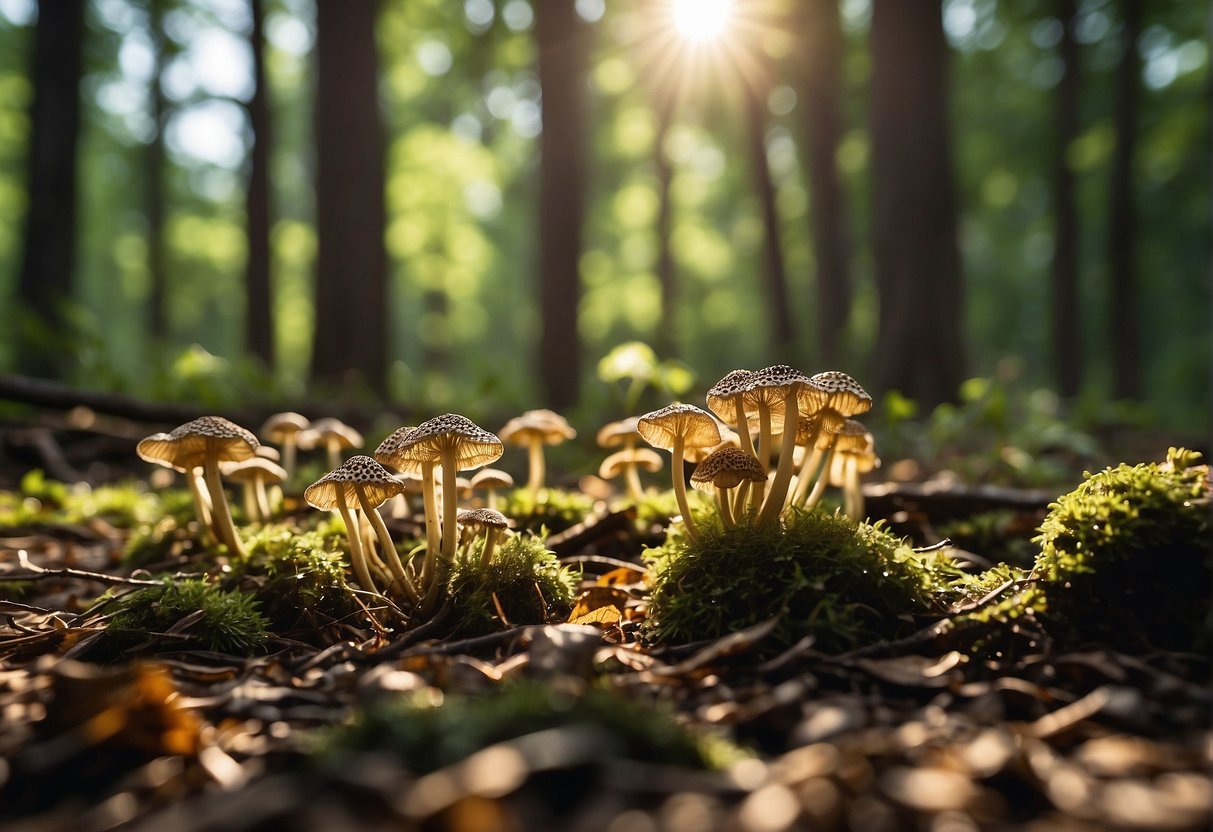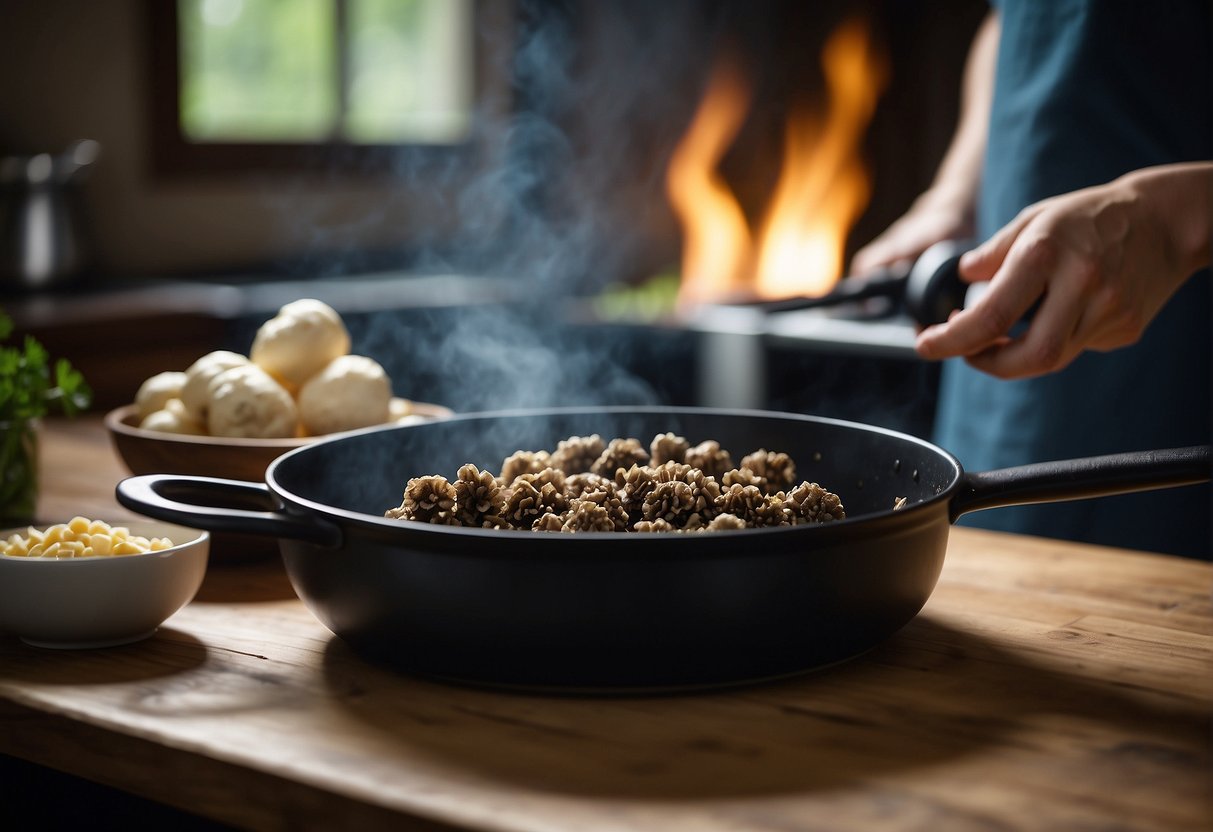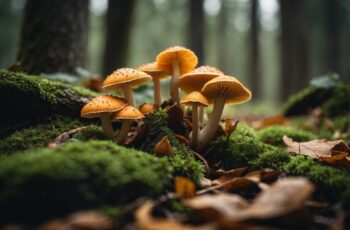Every spring in Indiana, you’re given the chance to indulge in one of nature’s most intriguing treasure hunts: the pursuit of morel mushrooms. These distinctive fungi, with their honeycombed caps, are not only a delicacy but also a symbol of the Hoosier state’s rich natural diversity. As you traverse the damp wooded areas across the state, you become part of a long-standing tradition that expert and novice foragers alike eagerly anticipate each year.

The prime time for morel hunting in Indiana spans from early April to late May, a period when the woods come alive and the ground conditions align perfectly for these elusive mushrooms to grow. Whether you’re exploring the hardwood forests of southern Indiana, which are known for their plentiful morel bounty, or venturing into the less-disturbed natural areas around the state, having a keen eye and local knowledge can make all the difference.
Morel mushrooms offer you more than just an adventure; they are a tasty treat that many consider a springtime delicacy. While some hoosier foragers enjoy the solitude of the hunt, others appreciate the community and camaraderie that comes with sharing locations and preparation techniques. Remember, these fungi are not only about the joy of the find but also about the experiences you gather and the stories you’ll tell for seasons to come.
Identifying Morels in Indiana
Finding and correctly identifying morel mushrooms in Indiana can be a rewarding experience. Here’s how you can accurately identify these seasonal delights.
Morchella Species Varieties
Morels in Indiana belong to the Morchella genus, and you’re most likely to encounter two primary species: the yellow morel (Morchella esculenta) and the common morel (Morchella elata). These species can often be spotted in woodland areas during the spring, from April through early June.
Physical Characteristics of Morels
When inspecting a morel, you should look for the following characteristics:
- Cap: Hollow, elongated, and somewhat conical with a distinctive honeycomb appearance consisting of ridges and pits.
- Stem: White to pale cream color, thick, and also hollow, typically attached at the base of the cap.
- Color: Morels range in color from a light cream to a dark gray or brown.
It’s important to note that the color can vary depending on weather conditions and the mushroom’s stage of maturity. If you’ve identified a mushroom with these specific characteristics, you’ve likely found yourself a morel. However, be wary of false morels which can be toxic; they typically have a cap attached at the top of the stem rather than the base and their cap structure is not truly hollow.
Remember, the hunt for morels can be as fulfilling as the find. So, use these guidelines as you search the forests of Indiana, and you may come across these delectable fungi.
The Morel Hunting Experience
Embarking on a morel mushroom hunt in Indiana is an exciting venture that combines the thrill of the hunt with the anticipation of a delicious reward. With the right gear and knowledge of tree identification, your forage in the Hoosier woods can be both fruitful and enjoyable.
Essential Gear for Mushroom Hunting
Before you set off into the woods, ensure you’re equipped with the essential gear for a successful morel hunt. A mesh bag or basket is a must-have for collecting mushrooms, allowing spores to spread and ensure future harvests. Wear comfortable, waterproof boots to keep your feet dry as you traverse through damp terrain. Bring along a knife to cleanly cut morels from the ground and a compass or GPS device to navigate unfamiliar woods confidently.
Tree Identification for Morel Foraging
Morels have a symbiotic relationship with certain trees, making tree identification a crucial skill for any hunter. In Indiana, morels often fruit in proximity to ash, elm, and sycamore trees. Look for dead or dying elms, as these are hotspots for morel growth. Recognizing the bark patterns and leaf shapes is key. Ash trees typically have a diamond-patterned bark, whereas elms display a more textured, furrowed bark. Keep in mind, with the emerald ash borer affecting many ash trees, these areas may be particularly rich with morels.
As you sharpen your identification skills and gear up, you’re setting the stage for a memorable and potentially bountiful foray into Indiana’s morel country. Happy hunting!
Morel Season in Indiana
The thrill of the hunt and the promise of a delicious find make the morel mushroom season a highly anticipated time in Indiana. Successful foraging hinges on knowing when and where to look.
Timing and Climate Conditions
Morel season in Indiana typically begins in early spring when the soil temperature consistently stays above 45 degrees Fahrenheit. You’ll want to start checking the forest floor after the first warm rains, as these conditions wake the morels from their winter slumber. In southern Indiana, the season can begin as early as late March, whereas the northern parts may not see morels until late April or early May.
State Parks and Public Land Hunting
Indiana’s rich landscapes, including its state parks, offer a bounty of hunting grounds for morel enthusiasts. Pay particular attention to state parks with deciduous forests and moist areas, as morels tend to thrive in such environments. Remember, it’s crucial to know the regulations of each park or public land area before you begin your search. Happy hunting!
Cooking and Preserving Morels

When it comes to the unique taste of morels, proper preparation and preservation are key to enjoying their full flavor. Remember, they’re not just any edible mushroom; they’re a seasonal delicacy in Indiana that warrant special attention in the kitchen.
Preparing Morels for Cooking
Before you dive into cooking, make sure your morels are dirt-free. Wash them gently but quickly under cold water and pat them dry. It’s crucial to minimize their time in water to prevent them from becoming soggy. Once they’re clean, slice them in half lengthwise to ensure they cook evenly.
You can start simple by sautéing morels in butter which brings out their earthy, nutty flavor. When sautéing, aim for a golden brown color, which typically occurs after about 5 minutes. Depending on the recipe, a pound of morels can elevate anything from a steak dish to a creamy pasta.
Preservation Techniques
If you’ve had a bountiful forage and want to enjoy morels year-round, preservation is your friend.
Drying is a trustworthy method. Spread your cleaned morels on a baking sheet and then dry them at a low temperature until they’re brittle to the touch. For more details on oven drying specifications, you can refer to the Frozen Morels Guide: Preserving Flavor and Quality.
Alternatively, freezing allows you to preserve that unique morel taste. Cook the morels first as they freeze best once they’ve been heated through. Then, cool them down, package them in airtight containers or zip-lock bags, and place them in your freezer. This method preserves both their taste and texture as if you’ve just harvested them. For specifics on sautéing and freezing techniques, take a look at the guide on Frozen Morel Mushrooms: Ultimate Guide to Preserving Flavor and Quality.


